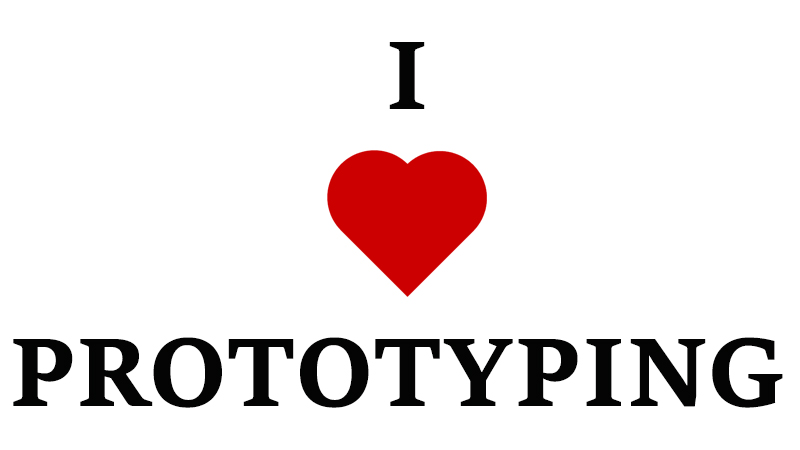Prototyping. An overused buzzword? A misunderstood concept? A noun, a verb, and an adjective? Prototyping is a philosophy. Actually, prototyping is the philosophy when it comes to making top notch designs in today’s hyper competitive market.
When most people think of a prototype, they are thinking of a comprehensive physical prototype (also called a pre-production, alpha, or beta prototype). Essentially a version that looks and functions like the final product. A completed design, less some bells and whistles and manufacturing issues, which need to be resolved to bring it to production. They are thinking of one very specific kind of prototype on one end of the prototyping spectrum. They imagine the concept car at the auto show, with a model making elaborate arm gestures towards it. We need to break away from this notion, and do a paradigm shift, so when people think of a prototype, they think messy not sexy, and grimey not shiny.
This topic has been written about extensively. In fact, it has been hammered more over the course of its lifetime than an ingot of brass alloy into a cymbal. But I am going to pull from some of my favorite writings on the topic, and try to put my own spin on it, because I am a renegade designer and that’s what I do.
Defining Prototyping
If someone asked you “What is a prototype?” Would you be able to answer? What would your answer be? When I thought about it myself, I found it surprisingly difficult to define. Sort of like defining what is “love”. So let’s talk about love and prototyping.
Before we define a prototype, it is helpful to understand the purpose of a prototype. Prototypes are used for four basic purposes; learning, communication, integration, and milestones.
Textbook Definition One:
“The use of simplified and incomplete models of a design to explore ideas, elaborate requirements, refine specifications, and test functionality.” – Universal Principles of Design
Textbook Definition Two:
“An approximation of the product along one or more dimensions of interest.” – Product Design and Development
There are many more dry and technically correct definitions of a prototype. But we can’t talk about prototyping without talking about risk. Specifically, prototypes are all about mitigating risk. In the book, Great by Choice, they use the analogy of “First bullets, then cannonballs”. Using this analogy, they define a bullet (prototype) as “a low-cost, low-risk, and low-distraction test or experiment.” Conversely, a cannonball is an idea that an organization puts a large amount of organizational resources and energy into. The purpose of bullets is to refine aim, and calibrate a trajectory before firing a cannonball. Because cannonballs sink ships, not bullets.
Let’s apply this concept to the example of an injection molded enclosure for a medium sized electronics device. The first step be might be to fire aesthetics “bullets” like researching enclosures for similar or competing products, hiring an industrial designer to create some concept models, and requesting color and texture samples from vendors. Then you might fire some function “bullets” like running mold flow analysis, stress analysis on snap fits, and then ordering an outsourced stereolithography model. This is all in preparation for the “cannonball”, of costly, time consuming, and permanent mold tooling.
Analytical vs. Physical Prototyping
Virtual prototyping is when the designer takes the white board drawing from the meeting and starts modeling it in 3D CAD with dimensions, quickly realizing it is totally not to scale, and completely infeasible. This hopefully takes only a few hours, and in the grand scheme of the overall project, the time and cost is negligible. Remember this, paper money and boyfriends/girlfriends need to be real, prototypes do not. At least not to start. Virtual prototyping is generally the first tool in the modern designer’s shed. The benefits of virtual prototyping are huge, in that cost (risk) is low, it is easy to make changes, and it is a powerful communication tool. Parameters can be easily changed with a few clicks of a button. The color of the exterior can be changed, or initial conditions of a finite elements analysis changed almost effortlessly, as opposed to the real world of painting or designing and building test fixtures. Analytical prototyping allows for testing fit and assembly, manufacturability, form and style, kinematics, finite elements, crash testing, and many other that can all be simulated with modern software packages.
Read more at SolidSmack.com


